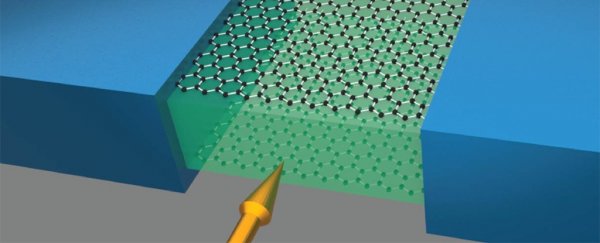Often it's the most minute scientific measurements that are the most important, and researchers have developed a new, super-small device that's capable of detecting magnetic fields even when they're extremely faint.
The device, a new kind of superconducting quantum interference device (SQUID), is just 10 nanometres high, or around a thousandth of the thickness of a human hair. It's made from two layers of graphene – making it one of the smallest SQUIDs ever built – separated by a very thin layer of boron nitride.
These fascinating devices are already used in fields as diverse as medicine and geology, and they effectively get electrons working as quantum bits. This latest SQUID design should make the tiny instruments even more useful to scientists, thanks to its ability to detect very weak magnetic fields.
"Our novel SQUID consists of a complex, six-layer stack of individual two-dimensional materials," says physicist David Indolese from the University of Basel in Switzerland.
 A conventional SQUID (left) and the new SQUID (right). (University of Basel, Department of Physics)
A conventional SQUID (left) and the new SQUID (right). (University of Basel, Department of Physics)
"If two superconducting contacts are connected to this sandwich, it behaves like a SQUID – meaning it can be used to detect extremely weak magnetic fields."
Conventional SQUIDs work as a ring – a superconducting loop that has two 'weak link' points. By analysing the travel of electrons around this loop, and the threshold at which the SQUID stops being a superconductor, magnetic fields can be measured.
While these devices are already able to spot faint magnetic fields, the size of the weak links is a limitation. By switching to a stacked design, rather than a loop, the team behind the new SQUID can detect magnetic fields that are even fainter.
One possible if rather technical application of SQUIDs is in looking closely at topological insulators: materials that act as insulators, but which also can have electrons travelling over their surface.
"With the new SQUID, we can determine whether these lossless supercurrents are due to a material's topological properties, and thereby tell them apart from non-topological materials," says physicist Christian Schönenberger from the University of Basel.
Anywhere that magnetic fields need to be measured, SQUIDs are important: in monitoring heart or brain activity for example, or in detecting differences in the composition of rocks. Now, those measurements can be even more precise.
This won't be the latest SQUID-related innovation we see. Scientists are experimenting with different types of materials and nanostructures to get the devices smaller and more accurate than ever before.
Meanwhile, the miniscule SQUID outlined in this study is ready to be deployed. The scientists are able to change its sensitivity by adjusting the distance between the two graphene layers, and by tweaking the current put through it. We're already looking forward to the discoveries that it leads to.
The research has been published in Nano Letters.
